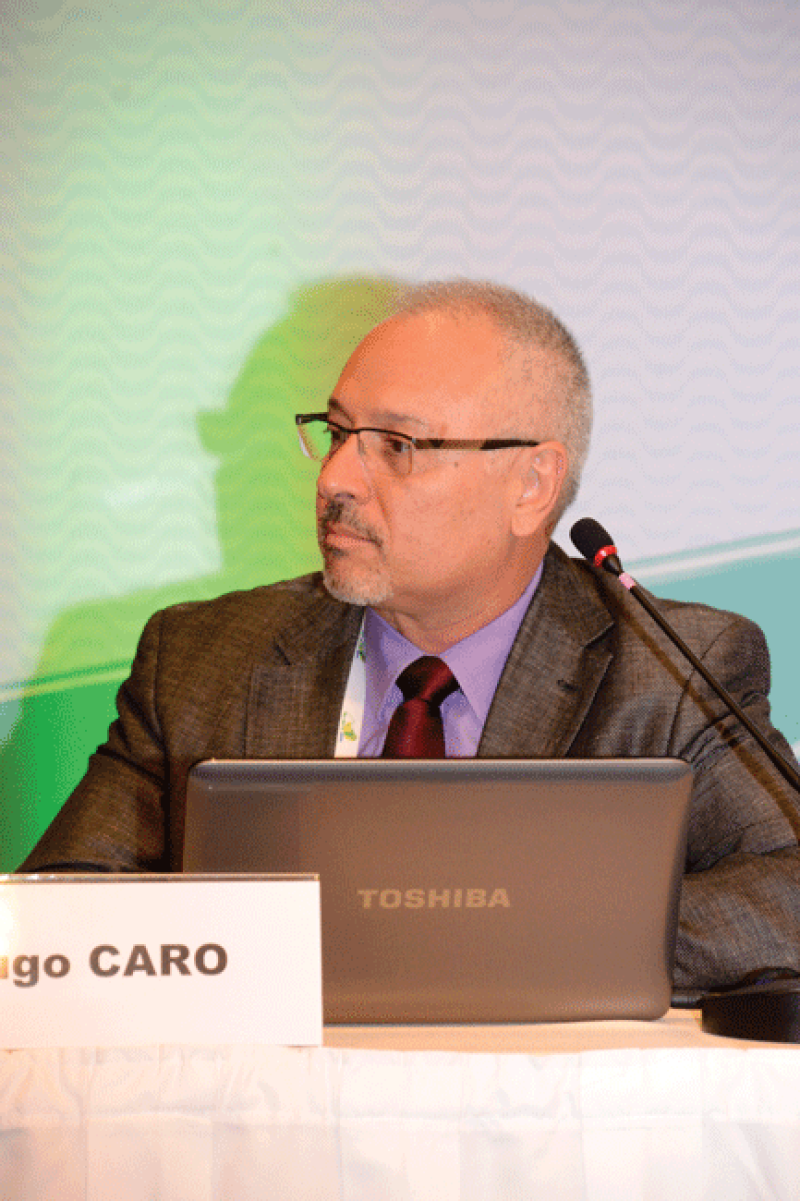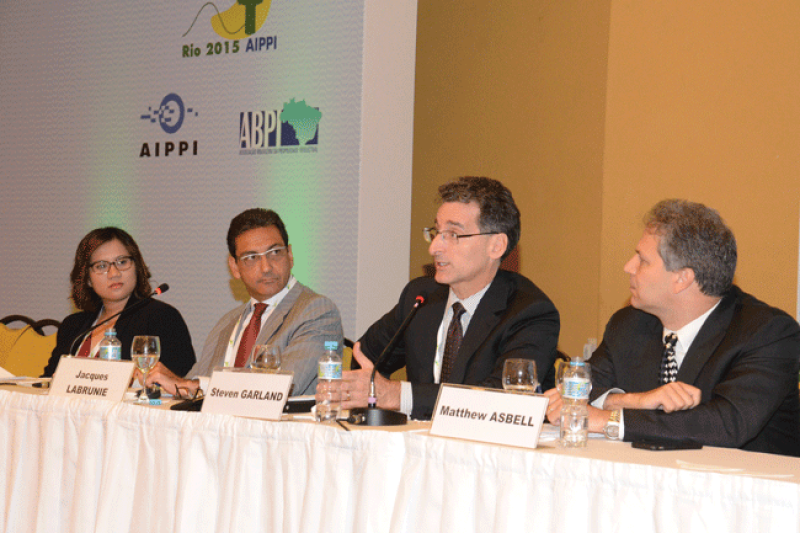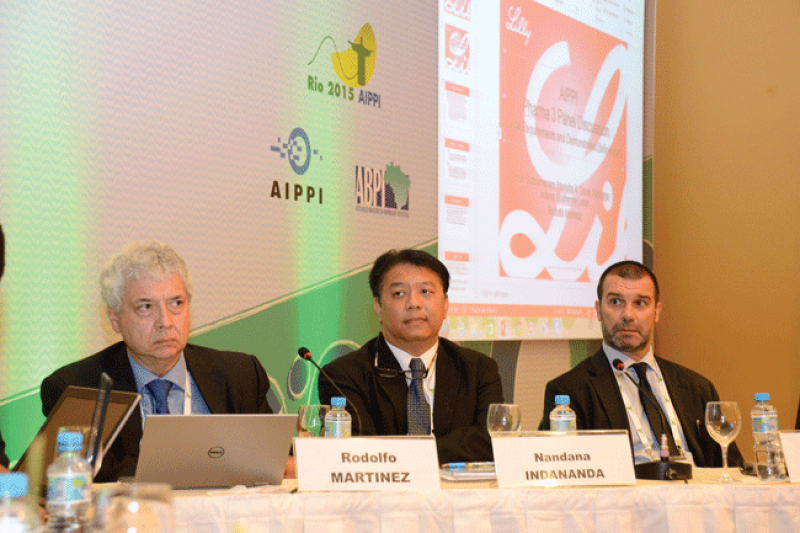The Myriad difficulties of patenting

Attendees heard about the continuing effects of the US Supreme Court’s verdicts on patent eligibility in the “Personalised Medicine” pharma session during the Congress.
Adrian Looney of Pfizer noted the impact of the Court’s Myriad decision, which said DNA is not allowed to be patented. “That is a big issue for us in pharma and also the diagnostic world,” Looney said. “In oncology, almost 50% of the compounds are either natural products or derived from natural products. That is going to make it more difficult and what I am advising my scientists when they are looking at natural extracts is that we are going to have to have the conversation very early in the process and sometimes the molecule we want to develop we aren’t going to develop.”
He noted that one compound concerns a treatment for Alzheimer’s. “It might be the exception to the rule but we still would have preferred to patent it in the US.”
Also in the session, Hugo Caro, head of Ferrer Internacional, gave an update on the new patent law in Spain. Article 6 of the new law passed in July 2015 contains a text mirroring Article 54 of the European Patent Convention. This stipulates that novelty will reside in the disease to be treated, the dosage required, the technical effect, synergies with other compounds and the group of patients to be treated.
In the case of European patents, the Spanish courts would normally accept the validity of Swiss-type claims filed or having a priority date earlier than January 29 2011 and the validity of purpose-limited product claims granted by the EPO in accordance with decision GO2/08, he noted.
“At present there is not sufficient case law interpreting the scope of the terms ‘treatment’, ‘treating’, ‘use to treat’ and similar expressions, but one could expect a Spanish court to interpret these terms according to their new natural meaning,” said Caro.
Double trouble for trade mark approval

The difficulty of getting through a double examination by two agencies when trying to get a trade mark registered was discussed in the pharma track session “Don’t miss the (right) mark” yesterday. The differing experiences of Brazil, the US, Canada and the Philippines were analysed by panellists.
Jacques Labrunie of Gusmao Labrunie in Brazil moderated the session and revealed this issue is a big problem in his country. Trade marks are regulated by both the patent and trade mark office and the health surveillance agency Anvisa.
This causes many problems. “It is a lot of work for all the Brazilian pharmaceutical industry concerning the trade marks,” he said. “You have the trade mark regulated at the BPTO and at Anvisa so you need to allow more time to think about it [when attempting to register a mark],” he said. “And they have different rules to each other.”
Before choosing a trade mark, you must see if it is available at the BPTO and check with Anvisa that there are no confusingly similar names registered.
“The understanding of confusion is a little bit different as well,” said Labrunie. “So having these two agencies is a challenge in Brazil.”
Anvisa issued a new rule, Number 59, in October 2014, which introduced new regulations of pharmaceutical names and marks. This eliminated the requirement for three separate letters to disassociate similar word signs, extended Anvisa’s discretionary power on regulating names and marks, and included some definition of elements of the regulation.
US, Canada and the Philippines
Matthew Asbell from Ladas & Parry in the US explained that his country also has an onerous double process. USPTO registration considers prior federal marks, distinctiveness and significance, and compliance with other statutes, but FDA approval is also required. The FDA analysis needs no priority, and uses POCA phonetic and orthographic computer analysis, scripting review of what a mark may look like when hand written. It also reviews packaging for the relative size of the company and international non-proprietary names (INNs).
The FDA approval process can cause frustration because there are limited legal arguments available and the rationale for refusal is not always given.
“That the FDA doesn’t always give a reason makes it a bit of a challenge,” said Asbell. “Some legal steps can be taken but sometimes it is just guesswork [for why approval was not given], which makes it problematic.” Applicants can look to assistance from the WHO if the stem is included or file a citizen’s petition asking for the reason for denial.
“There is a higher standard at the FDA,” Asbell said. He added that the double process should be done simultaneously to avoid what he called a “train wreck scenario”, where an application is accepted by the USPTO but then rejected by the FDA.
Asbell also revealed that new rules were released in September covering biosimilars. Biosimilars will be approved based on: a high similarity to an FDA-approved biologics product; no clinically meaningful differences in terms of safety, purity and potency; the same clinical result with no difference in safety or efficacy when alternating with the reference product; and avoiding inadvertent substitution without intervention of an MD.
“It remains to be seen how this will be implemented because this is a new guidance that only came out a month ago,” said Asbell.
Steven Garland from Smart & Biggar in Canada said his country has a similar double process challenge. He said the sweeping changes to its Trademark Act last year will have a big impact. “The Act has been fundamentally amended and will be coming into force in 2017,” he said. “It will have an effect on pharmaceutical companies and brands.”
The requirement for use has disappeared. But to keep a mark there must be use, with challenges allowed after three years. “You could imagine if you are a pharmaceutical company, this could become problematic,” said Garland, noting the long approval process to register a drug. “It remains to be seen how that is treated,” he said.
Another change is anything filed after June 13 2015 will require inclusion of brand name assessment. One possible result is that Health Canada will refuse to issue a notice of compliance if the brand name is deemed unacceptable and the sponsor does not wish to move forward.
Health Canada brand name assessment will include initial brand name review for naming practices that could render the proposed name misleading, all brand names will also require a LASA (look alike sound alike) assessment (subject to some exceptions), and the sponsor must assess whether there is a likelihood of confusion between a proposed name and other product names authorised for use in Canada. “They are more onerous and I think fair to say more complex,” said Garland of the requirements.
Rowani Nakan of Cruz Marcelo & Tenefrancia in the Philippines said there is “is a disconnect between the IP Code and FDA” in her country. In contrast to the other countries discussed, the double process is less of a challenge in the Philippines. “Unlike the US, our FDA does not have a stringent process,” she said.
The FDA does not allow registrations identical to those already registered with the FDA, but it doesn’t check with IPO registrations. “The FDA doesn’t care about what the IPO has in its database,” she said.
If challenges are made, the FDA merely notifies the opposer that IP matters are beyond its jurisdiction and should be addressed to the IPO or the relevant courts.
Nakan concluded with some recommendations. Since the Philippines IPO and FDA independently evaluate the validity of a proposed mark, applicants should comply with both IPO and FDA requirements. While the FDA does not yet have a specific rule in place against the use of an INN as a brand name, applicants should refrain from using the INN because they will encounter challenges in registering the brand name as a trade mark, she said.
Strong feelings on compulsory licensing

There was what Assistant Secretary General Ralph Nack called an “exciting and controversial” debate on compulsory licensing, featuring representatives of the pharmaceutical industry and lawyers from India, Brazil, Thailand and the US.
The context was the recent grant of compulsory licences for medicines in countries such as India, Indonesia and Thailand. Manisha Desai of Eli Lilly in the US said that granting compulsory licences leads to uncertainty for businesses – adding “the worst thing for us is uncertainty” as it means less incentive to invest and long-term increases in costs.
But Rodolfo Martinez of Martinez & Associates in Brazil said: “It is unfair to use the expression ‘uncertainty’ when you’re playing by rules established 100 years back in the Paris Convention.”
He later added: “I don’t think the compulsory licence is a positive instrument. But you have to look at the domestic market in each country. In a country like Brazil where the government is footing the bill, price becomes a matter of interest.”
Guilherme Leser of Merck (MSD) in Brazil noted that policies on compulsory licensing are often driven by political considerations, making it difficult to predict long-term trends. Brazil, for example, has its second health minister within a year. “I don’t see any pharmaceutical company investing in R&D in a country where there is uncertainty,” he added. Merck had a compulsory licence granted on a drug in Brazil in 2007.
The panel, chaired by Hari Subramaniam of Subramaniam & Associates, discussed recent cases including the pending Lee Pharma v AstraZeneca case in India, concerning compulsory licence applications for the drugs Onglyza and Kombiglyze. They also addressed the national and international legal frameworks and whether importation can or cannot constitute working an invention, and Brazil’s so-called Productive Development Partnerships (PDPs), designed to promote technology transfer in the country.
It was a session that did not offer any easy answers, but did show the strength of feeling on all sides. As Desai, who was born in India, said: “I want to see the environment improve so Indians can have access to our latest medicines. There is no certainty that is going to happen.”









